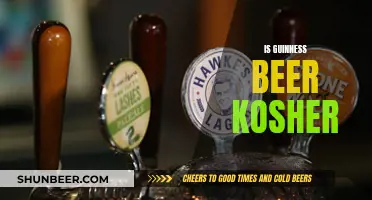
India Pale Ale, or IPA, is a popular style of craft beer. While IPAs are known for their bitter taste, not all IPAs are bitter, and not all of them have a high alcohol content. The style has evolved to include a range of flavours, including fruity and malty notes. To enjoy an IPA, it is recommended to drink it from a glass, rather than a can or bottle, to appreciate its aroma and flavour. The ideal serving temperature for an IPA is around 45 to 50 degrees Fahrenheit, and it is best to drink it fresh.
| Characteristics | Values |
|---|---|
| Temperature | 45-50°F (warmer for double IPAs) |
| Glassware | Use an IPA glass to enhance the aroma and flavour |
| Pouring technique | Hold the glass at 45 degrees and pour the beer down the side of the glass |
| Aim for about half way down the glass | |
| Once you’ve poured about half the beer, return the glass to an upright position and continue pouring | |
| Increase the space between the can/bottle and the glass to increase agitation and the head it produces | |
| Aim for a 1-1.5-inch head of foam | |
| Drinking technique | Take small sips and repeat smelling the beer |
| Drink slowly to allow the beer to warm up | |
| Beer type | Try a New England-style IPA if you find West Coast IPAs too bitter |
| Try a West Coast IPA if you find New England-style IPAs too sweet | |
| Try a lower ABV IPA before trying a Double IPA | |
| Try a fresh-hopped IPA for an intense, fresh flavour |
What You'll Learn

Try different types of IPA
IPAs, or India Pale Ales, are extremely popular and come in a range of styles. The West Coast IPA is known for its fruity hop explosion, with big tropical fruit notes. The New England IPA is unfiltered, hazy, and has very low bitterness. The British IPA is malty, bitter, and one-noted. The East Coast IPA is a stepping stone between the British and West Coast IPA, with an emphasis on piney hop flavour.
If you're new to IPAs, it's worth trying a few different types to see what you like. Here are some recommendations to get you started:
- For a West Coast IPA, try Sierra Nevada Brewing Co. or Stone Brewing Company.
- For a New England IPA, try Hill Farmstead Brewery, Civil Society Brewing Company, or Trillium Brewing Co.
- For a British IPA, try Great Lakes Brewing Company, Yards Brewing Company, or Samuel Smith's Brewery.
- For an East Coast IPA, try Dogfish 60 Minute or Victory Hop Devil.
Remember, the perfect IPA for you is out there—you just have to find it!
Guinness Beer and Coffee: What's the Connection?
You may want to see also

Experiment with temperature
The serving temperature for IPAs is a very important factor in enhancing the drinking experience. Most recommend a temperature of 45 to 50 degrees Fahrenheit for IPAs, and perhaps a touch warmer for double IPAs.
If you're storing your beer in a refrigerator, it's a good idea to let it sit for about five minutes before serving to take the deep chill off. This is because IPAs are best enjoyed when they are a little warmer than ice-cold. As you drink the beer, it will gradually warm up, and you may notice some flavour differences as this happens.
The ideal temperature range for IPAs allows you to appreciate the full spectrum of flavours and aromatics. When served too cold, you may miss out on the fruity aromatics and more subtle tasting notes. As the beer warms up, these flavours will become more pronounced.
For example, at colder temperatures, you may find the IPA to be more bitter. However, as the beer warms, you'll uncover layers of flavour and reveal a change in taste. This change in temperature can often lead to a more enjoyable drinking experience, allowing you to discover new nuances in the beer.
Therefore, don't be afraid to experiment with the serving temperature of your IPA. Letting it warm up slightly can make a big difference in how you perceive the beer's characteristics.
Guinness Beer vs. World Records: What's the Difference?
You may want to see also

Use the right glassware
Using the right glassware can elevate your IPA drinking experience. The shape of the glass you use will impact the foam or "head" that forms at the top of the glass after pouring. The thickness and retention of the head affect the aroma of the beer by capturing compounds such as fermentation by-products and hop oils. Therefore, the type of glass you choose will significantly impact the visual presentation of the beer and the customer's first impression.
A great IPA glass will capture and deliver the aromas to your nose, so any glass with a bulbous shape that tapers inward at the top is ideal. Additionally, some glasses are designed to maintain the head for longer, enhancing the drinker's experience of the aromatics. Since aromatics play a crucial role in IPA beers, preserving the head of the beer is essential.
While there is no single perfect glass for all IPAs, here are some popular options:
- The Tulip Glass: This glass is excellent for capturing and channelling aromas into your mouth, similar to a wine glass. It has a bulbous lower half and a gently flared rim. While you can drink a lager in a tulip glass, it truly shines with complex stouts, IPAs (unless they are overly hoppy), and Belgian beers.
- The Rastal Teku Glass: This glass combines the tulip glass's general shape with the stem of a wine glass, preventing your hand from warming the beer. It is ideal for pure tasting due to its low widest spot.
- The Spiegelau IPA Glass: This glass is designed to balance hoppy beers and create the best tasting experience. It features a wide, hollow stem and an elongated bowl that tapers slightly at the top. The ridges in the hollow stem help aerate the beer by increasing surface area and friction, breaking up the aromatics. The length of the bowl directs the aromatics towards your nose in a focused stream.
- The Snifter: A smaller, snifter-type glass is ideal for stronger, special brews such as rich, syrupy old ales or barley wines with high ABV.
- The Wine Glass: Using a wine glass for beer tasting is perfectly acceptable, according to beer expert Randy Mosher. The tapered bowl shape captures aroma, and the stem keeps your hand from warming the beer. Just make sure not to fill it above the halfway mark.
Guinness Beer: Unveiling the Statistics Behind the Perfect Pour
You may want to see also

Pair with food
Pairing IPAs with food can be a little tricky, but it's a great way to discover more than just "bitter" flavours in your beer. The key is to harmonise flavours, either by contrasting them or finding like-for-like matches. Remember, the lighter the beer, the lighter the dish.
The aromatics of Thai food, for example, match those of an IPA. The key is not to overpower the beer, so avoid making your dishes too spicy. Something like a green curry is ideal—the lemongrass and coriander will merge well with the citrus and herbal hops. Burgers are another great match, but make sure your toppings aren't too aggressive; avoid a blue cheese attack!
Oily fish, such as salmon or mackerel, also work well with a strong, thick beer like an IPA. Serving it with traditional lemon is a perfect match for the drink, but try a mango salsa or salsa verde to bring out more subtle nuances.
Many IPAs have tropical notes, so accentuate them with juicy mango. It works well with a simple dessert like a syllabub, or try combining it with salty flavours like ham in a salad, or with lightly curried Coronation chicken.
If you're looking for something a little more exotic, beer picks up on the base Vietnamese flavours of lime, galangal and tamarind, plus it's a good contrast to creamy coconut and tangy fish sauce. Try an aromatic pho soup with light rice noodles, or a fresh, crunchy salad with ribbons of carrot and cucumber.
Finally, a great way to finish off a meal is to serve your final IPA with a lemon tart or orange cake. Key lime is good too, but make sure it isn't too sour.
Guinness Beer: Kosher Certification and Jewish Drinking Traditions
You may want to see also

Learn about the history
The history of India Pale Ale (IPA) is a fascinating one, and it involves the British Empire, the East India Company, and the quest to create a beer that could survive a long sea journey.
The story of IPA begins in the 18th century when the British Empire had a significant presence in India. The British soldiers, sailors, and civilians in India had a strong desire for beer, but the traditional beers they were used to drinking could not withstand the long voyage to India and often spoiled. The dark porters that were popular at the time were also not well-suited to the hot Indian climate.
George Hodgson of the Bow Brewery in London is often credited with creating the first IPA. He began brewing a lighter style of beer with more bitterness, known as pale ale. Hodgson realised that adding extra hops and increasing the alcohol content could help preserve the beer during its journey to India. His beer, known as "October beer" or barley wine, was brewed with freshly harvested hops and was intended to be aged like wine. This beer not only survived the journey to India but was found to have improved in flavour.
However, the commonly told origin story of IPA is not entirely accurate. Ale and beer had been successfully exported to India and other colonies for a long time, and while there was some spoilage, the beer could last for a year or more in casks. Porter, the popular dark mild beer of the time, was also successfully shipped to India and remained popular throughout the 19th century. Pale ales had also existed for at least a century before Hodgson began brewing his version.
The key innovation that led to the creation of IPA was the addition of extra hops to beer being sent to warmer climates. By the 1760s, brewers were advised that it was "absolutely necessary" to add extra hops to beer destined for warmer regions. While Hodgson was not the first brewer to export beer to India, he became the best-known and most popular brewer of pale ales for the Indian market. His brewery's location, close to the docks used by the East India Company, also gave him an advantage over his competitors.
Over time, other brewers began to imitate Hodgson's beer and develop their own versions of IPA. The recipe was tweaked, leading to the creation of several varieties, including weaker pale ales produced for the British market. The popularity of IPA in Britain grew, and by the 1840s, it had become one of the country's best-selling beers. However, with the introduction of commercial refrigeration in the late 19th century, which revolutionised the shipping of perishable goods, IPAs became less common.
It wasn't until the 1970s that IPAs experienced a revival, thanks to American craft brewers who began experimenting with new styles of hops. The first American pale ale was brewed by Anchor Brewing Company in San Francisco, and it sparked a craft beer frenzy in the United States. The popularity of IPAs in the US eventually spread back across the Atlantic, and they once again became fashionable in Britain.
Today, IPAs come in various styles, including session IPAs, double IPAs or imperial IPAs, hazy IPAs or New England IPAs, and West Coast IPAs, each offering unique flavour profiles and brewing techniques.
The Hoppy IPA Beer Myth: Fact or Fiction?
You may want to see also
Frequently asked questions
While there is no right or wrong way to drink an IPA, there are certain techniques to get the most out of your beer. For example, it is recommended to drink IPAs at around 45-50°F, and to let the beer sit for a few minutes if you're taking it out of the fridge. You should also use a clean glass to avoid impacting the flavour of the beer. When pouring, hold your glass at a 45° angle and pour the beer down the side of the glass until it's about halfway full, then return the glass to an upright position and continue pouring.
If you're new to IPAs, you might want to start with a pale ale, which has a less intense hop presence. Some recommendations include Sierra Nevada Pale Ale, Oskar Blues Dale's Pale Ale, and Anchor Liberty Ale.
Not all IPAs are bitter. New England-style IPAs are unfiltered, hazy, and have extremely low bitterness. Some recommended New England IPAs include those from Hill Farmstead Brewery, Civil Society Brewing Company, and Trillium Brewing Co.







